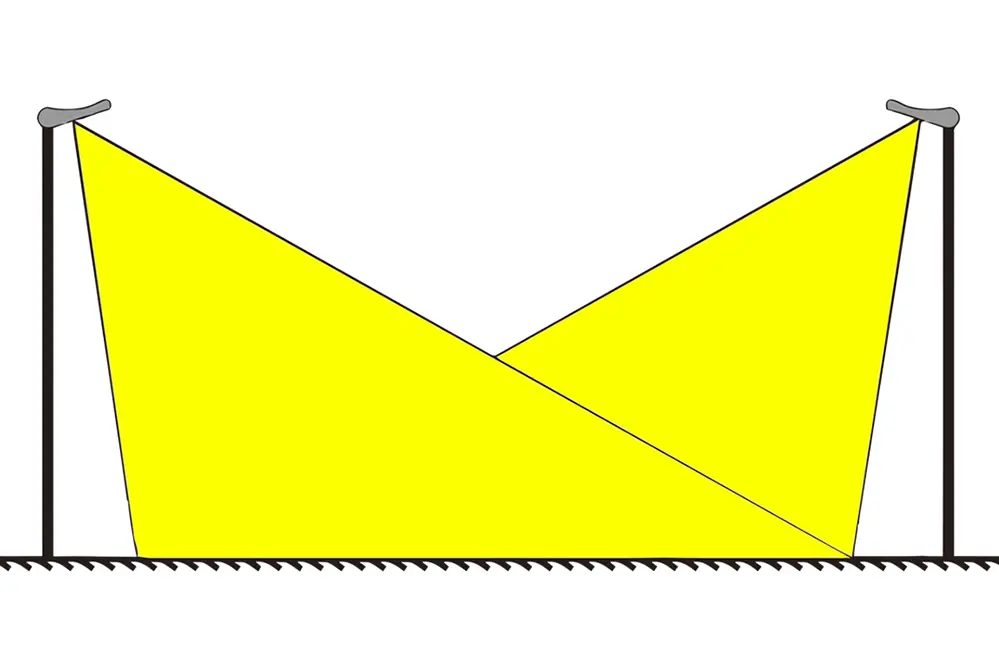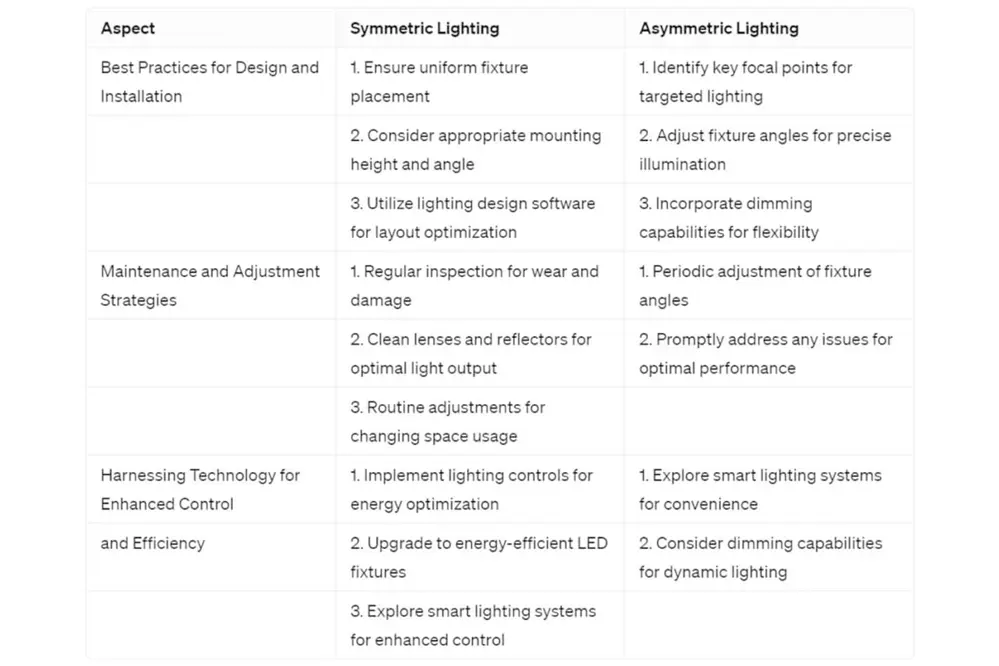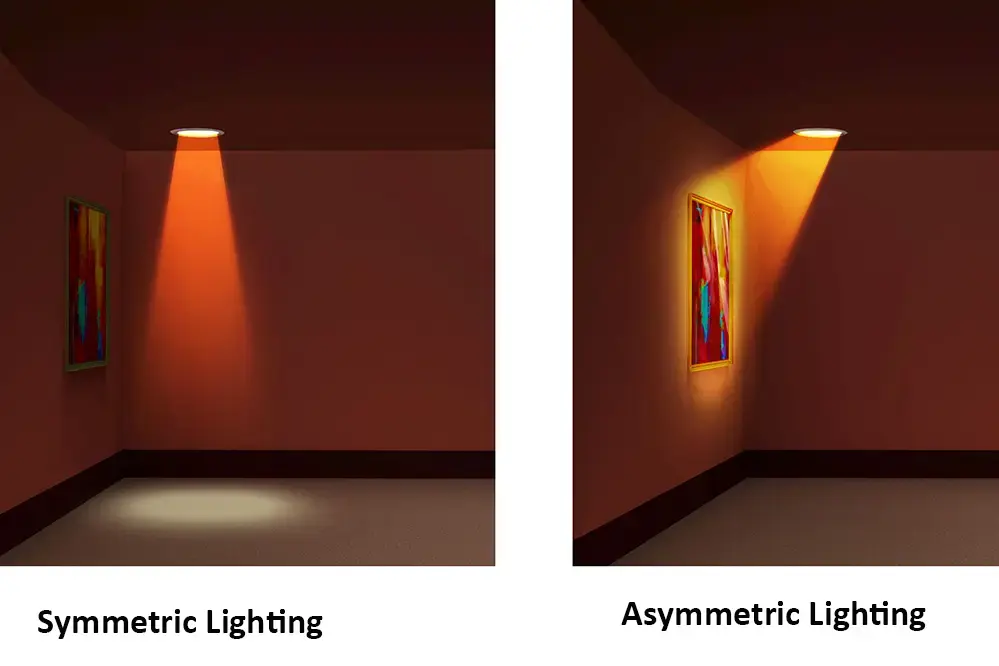In the realm of interior design, the choice between asymmetric lighting vs symmetric lighting can redefine the ambiance, luminance, and functionality of any space. Imagine entering a room where the lights subtly highlight a stunning piece of art, creating a dynamic and engaging atmosphere. This is the transformative power of asymmetric lighting, which contrasts with the balanced and harmonious feel of symmetric lighting. Understanding these differences is crucial for designers and homeowners alike, as lighting can dramatically influence mood and functionality.
Lighting is not merely about visibility; it’s about crafting an experience that resonates with the occupants. Research indicates that well-designed lighting can enhance productivity by up to 20% in workspaces and improve mood in residential settings. This makes the choice between asymmetric and symmetric lighting not just a matter of aesthetics, but a strategic decision that impacts well-being and efficiency. Surprisingly, many people underestimate the profound effects lighting can have on our daily lives, often defaulting to outdated or inappropriate choices.
As we delve into the nuances of asymmetric lighting vs symmetric lighting, you’ll discover how each approach can be leveraged to achieve specific design goals. Whether you’re looking to create a cozy reading nook or a vibrant office environment, understanding these lighting strategies will empower you to make informed decisions. Join us on this illuminating journey to unlock the potential of your spaces.
What Is Asymmetric Lighting?
Asymmetric lighting stands as a transformative force in the realm of lighting design, injecting spaces with functionality and sophistication.
In recent years, lighting designers, in their quest for holistic ambience, embraced asymmetrical lighting to create dynamic visual interest without compromising comfort. This technique involves strategically directing light to specific areas, allowing for precision and efficiency in illumination.
Unlike symmetric lighting, where light distribution is balanced, asymmetric lighting intentionally focuses on varying intensities, facilitating a room’s central themes and enhancing specific objects. Artists and architects often utilize this approach to emphasize textures and colors with remarkable clarity.
Asymmetric lighting solutions are particularly valuable in complex environments, from museums, where the light must dance around exhibits, to urban developments, which require tailored solutions for efficiency. This approach fosters creativity, elevates design, and supports innovative architectural endeavors with great promise.
Incorporating asymmetric lighting can transform ordinary spaces into extraordinary experiences, inviting us to reimagine the potential of our surroundings.
What Is Symmetric Lighting?
Symmetric lighting refers to the even distribution of light across a space to achieve uniformity and balance.
In recent years, symmetric lighting, a reliable practice in illumination engineering, consistently ensures environments are well-lit with equal light intensity throughout spaces, supporting functionality and fostering a sense of calm.
Symmetric lighting excels in areas where consistent brightness is vital, such as office spaces, classrooms, or libraries, where it plays a fundamental role in reducing strain and enhancing productivity.
Unlike asymmetric lighting, which highlights select features, symmetric lighting’s steady approach provides a serene ambiance, simplifying the environment and promoting focus, benefiting those who thrive in structured settings.
Symmetric lighting continues to provide effective, uncomplicated solutions for spaces requiring uniform illumination.
Key Differences Between Asymmetric and Symmetric Lighting

Asymmetric lighting, a dynamic illumination strategy, directs light precisely. Symmetric lighting ensures even light distribution, creating balance. Asymmetric lighting emphasizes specific features or zones, enhancing depth and creativity, while symmetric remains grounded in uniformity, fostering clarity.
Direction and Distribution of Light
In lighting design, the distribution of illumination is vital in crafting inviting and efficient environments. Asymmetric and symmetric lighting achieve these goals through unique directional properties.
Symmetric lighting evenly distributes light, creating an atmosphere of consistency and order. This method is ideal for areas demanding uniformity, such as academic and corporate settings.
Asymmetric lighting artfully draws attention to architectural details, enhancing visual interest and dynamic aesthetics within a space.
Conversely, asymmetric lighting directs light strategically to enhance specific zones or elements, creating an engaging contrast of light and shadow. This technique is perfect for artistic and architectural applications, where creativity and focal interest are paramount. Both approaches harness the transformative power of light, enabling us to engineer spaces that captivate the senses while fulfilling functional needs.
Visual Comfort and Glare
In the realm of lighting, visual comfort and glare profoundly influence our spatial experiences and productivity.
Visual comfort, an often underestimated aspect of a well-designed space, ensures environments are pleasing and conducive to human activity. Symmetric lighting, with its balanced illumination, minimizes glare and distractions, creating a harmonious visual field. This orderly distribution of light fosters an environment where comfort and clarity coexist, empowering individuals to engage and perform at their peak.
In contrast, asymmetric lighting, possessing a unique capacity to highlight particular areas, can occasionally introduce glare if not meticulously planned. However, with thoughtful design interventions, asymmetric lighting can beautifully balance the need for focal highlights with overall comfort, enhancing both utility and aesthetic charm.
Ultimately, the decision between symmetric and asymmetric lighting solutions should be guided by desired visual outcomes and the specific needs of a space’s occupants. By prioritizing visual comfort, lighting designers can effortlessly blend functionality with aesthetics, ensuring spaces that not only look good but feel good to inhabit. This balanced approach not only amplifies the visual appeal of the environment but also maximizes cognitive performance and well-being, offering a luminous path forward in the pursuit of enlightened spaces.
Benefits of Asymmetric Lighting
Asymmetric lighting, deliberately designed to direct light, skillfully enhances users’ focus, thus optimizing their productivity and creativity.
By its nature, this lighting can strategically minimize shadows (and) reduce glare in areas of concentrated activity, thus leading to heightened visual comfort and enabling those in asymmetrically lit spaces to remain alert and performance-driven.
The terms “directed” and “intentional” work synergistically to describe the ‘selective precision.’
Enhanced Ambiance
Asymmetric lighting creates a dynamic atmosphere by strategically directing light to accentuate architectural features, fostering a unique and inviting environment.
- Focal Points: Highlights specific areas or objects, creating interest and depth.
- Mood Settings: Offers flexibility to adjust ambiance based on activities or preferences.
- Shadow Reduction: Minimizes harsh shadows, providing a softer look.
- Energy Efficiency: Targets light where it’s needed most, reducing wastage.
Symmetric lighting offers a balanced, uniform glow ideal for creating harmony in areas requiring even illumination.
It enhances spatial perception, making environments feel comfortably large while ensuring visual consistency throughout the space.
Highlighting Architectural Features
Harnessing light creatively can vastly transform architectural spaces, spotlighting design elements with strategic brilliance.
- Elevation of Details: Crafts attention to architectural intricacies, bringing unique features into focus.
- Texture Enhancement: Emphasizes contrasting textures, adding depth and richness to surfaces.
- Accentuation of Lines: Highlights lines and patterns, accentuating design flows.
- Visual Hierarchy: Guides eyes across spaces, ensuring standout features receive deserved attention.
Utilizing asymmetrical lighting techniques emphasizes architectural nuances, creating a dynamic interplay between light and shadow.
In contrast, symmetric lighting delivers uniformity, establishing a cohesive ambiance while subtly foregrounding structural elegance.
Benefits of Symmetric Lighting
Symmetric lighting inherently promotes balance, a bastion of harmonious illumination, where each area receives tailored attention. This lighting technique fosters visual tranquility, making it an ideal choice for settings demanding equilibrium and understated sophistication.
In commercial and residential spaces alike, symmetric lighting is a “universal ally.” Whether it’s in the realm of a corporate office, ensuring efficiency and focus, or a home living space, its application is boundless. Used effectively, the symmetry of the lighting creates a seamless flow, reducing visual fatigue and fostering an environment primed for productivity and relaxation in equal measure.
Uniform Illumination
Uniform illumination achieves an even distribution of light across a space, minimizing shadows and contrast effectively.
In recent years, James Brodrick, a leading lighting industry representative, asserted that uniform lighting can enhance productivity and comfort, especially in task-oriented environments where consistent visual conditions are essential.
Thus, it’s no mere coincidence that uniformity’s approach to lighting is regarded as a cornerstone of design excellence, straddling the divide between aesthetic richness and functional brilliance with impeccable poise.
Uniform lighting paves the path for spaces where every corner pledges equal brightness, ensuring that no single area dominates the visual field. This cohesive approach generates a sense of spatial equality, which resonates with the human need for order and predictability while promoting concentration and comfort.
In conclusion, uniform illumination serves as a testament to the power of light in creating spaces that truly illuminate the potential for productivity and serenity.
Ease in Design and Installation
When considering lighting solutions, ease of design and installation is paramount, ensuring a seamless integration into any environment.
Asymmetric lighting stands out for its remarkable versatility.
With its ability to target specific areas, asymmetric lighting allows designers to create focused illumination without the limitation of uniform distribution. It offers exceptional flexibility, accommodating the nuanced demands of varied architectural designs and room functions.
On the other hand, symmetric lighting is lauded for its straightforward implementation, offering a method of evenly dispersing light that requires minimal adjustment. Its simplicity makes it ideal for a wide range of applications, enhancing spaces without the complexity of intricate design schemes. Whether opting for the precision of asymmetric solutions or the expansive simplicity of symmetric options, both provide robust pathways to achieve luminous excellence. Their respective benefits empower designers to “paint” with light, transforming spaces into brilliant canvases.
Ideal Applications for Asymmetric Lighting
Asymmetric lighting excels when tailored precision is paramount.
Galeries, museums, and retail spaces benefit immensely from this approach. The unique capacity of asymmetric lighting to focus on specific exhibits or display areas makes it an indispensable tool in creating highlighted contrasts. Consequently, art pieces or products can be showcased with unprecedented clarity and allure, captivating the observer’s attention effortlessly.
The options for educational and workspaces have also matured.
Libraries and auditoriums are perfect examples—here the nuanced task of illuminating workspaces is more than a necessity—it becomes an art form in itself. By achieving targeted, glare-free illumination, asymmetric lighting enhances focus and reduces strain in these environments.
From the impressive architecture illuminating urban landmarks to the sophisticated displays in avant-garde showrooms, the unique benefits of asymmetric lighting inspire a reimagined world. It sharpens contrasts and adds texture, allowing for an expressive interplay of shadow and light, stimulating both functional efficiency and aesthetic sensibility.
Ideal Applications for Symmetric Lighting
Symmetric lighting offers uniform illumination across spaces, ensuring that the lights provide a cohesive ambiance.
This even distribution makes symmetric lighting an ideal choice for environments that demand comprehensive visibility. For instance, commercial settings such as retail spaces, gymnasiums, and office interiors benefit from the balanced brightness that symmetric lighting provides. Besides, its role in the effective illumination of public places is increasingly evident.
Symmetric lighting aids in mitigating shadow presence.
The absence of severe contrasts or directional light enhances spaces where consistent light levels are essential – think of areas like airports, train stations, or large-scale retail outlets. Here, the need for clear, unobstructed visibility is paramount for both safety and navigational purposes.
Symmetrical illumination also serves to create visually appealing and welcoming environments, fostering a sense of openness and accessibility. Take museums as an example; the capacity of symmetric lighting to fill spaces elegantly with light provides a backdrop that allows art pieces and exhibits to stand out naturally, without overpowering their intrinsic charm. This artful blend of functionality and aesthetics underscores the transformative impact of symmetric lighting in modern design and architecture.
How to Choose the Right Lighting for Your Space

Lighting, much like a maestro guiding an orchestra, plays a pivotal role in shaping our environments. The right lighting choice can transform spaces as it dictates mood, ambiance, and functionality. Understanding the nuances of asymmetric and symmetric lighting provides a roadmap to achieving the perfect atmosphere tailored to your needs.
When selecting appropriate lighting, let the purpose of the space guide your decision.
Consider areas that demand focused light, like offices or art galleries, where asymmetric lighting shines (pun intended) in showcasing elements effectively.
Environments that thrive on even, consistent illumination, such as libraries and malls, benefit from the uniform quality of symmetric lighting.
Evaluate the space’s aesthetic and functional requirements to make an informed decision. It’s essential to consider how both lighting types can complement each other, thereby enhancing spatial dynamics.
Ultimately, the key lies in aligning your space’s needs with appropriate lighting styles. Thoughtful integration ensures the surrounding environment not only meets practical demands but also embraces elevated visual appeal.
Common Misconceptions About Asymmetric and Symmetric Lighting
In the world of lighting, several myths surround the distinction between asymmetric and symmetric lighting.
One prevalent misconception is that asymmetric lighting is inherently superior for all tasks requiring precision. While it is true that asymmetric lighting can enhance specific focal points, its utility isn’t universally applicable.
Conversely, some believe that symmetric lighting’s appeal is limited due to its uniformity, presuming it lacks the versatility to serve diverse environments. Symmetric lighting indeed excels in creating consistent illumination, but dismissing its flexibility does a disservice to its effective applications.
Another misunderstanding is the inability of both lighting types to coexist in a given space. Implementing a mix of asymmetric and symmetric lighting can beautifully merge functionality with style, allowing each to complement the other’s strengths.
Understanding these misconceptions allows one to harness the true potential of both lighting styles, ultimately crafting environments that are both inspired and purposeful.
Energy Efficiency Considerations
Achieving efficiency is a paramount design goal.
Energy savings often arise from the right choice of lighting. Both asymmetric and symmetric lighting offer distinct energy efficiencies based on their configuration and application. Typically, asymmetric lighting can minimize wastage by directing light exactly where it is needed the most. Conversely, symmetric lighting provides even distribution, which can be advantageous in spaces requiring consistent illumination.
The key is tailoring the lighting to the environment’s needs.
Opt for energy-efficient lighting fixtures—such as LED technologies—to enhance sustainable outcomes without compromising on quality or brightness. These innovations ensure that whether asymmetric or symmetric lighting is preferred, the energy consumption remains optimal and environmentally considerate.
With modern advancements in lighting technology, balancing efficiency and effectiveness in lighting design is more achievable than ever. By discerning the most appropriate lighting approach for each unique setting, one can confidently illuminate spaces that not only fulfill their functional roles but also contribute to a sustainable future.
Future Trends in Lighting Design
Lighting design is evolving at an unprecedented pace.
Advancements in technology promise even deeper integration of smart lighting systems. These systems are poised to offer real-time adaptive responses to environmental factors, thereby ensuring an optimal balance between aesthetic appeal and energy conservation. Moreover, there is an increasing trend towards using human-centric lighting solutions that adjust to the natural circadian rhythms to enhance well-being and productivity.
Sustainability continues to be the guiding principle.
Expect to see more innovations that leverage the power of natural elements – such as the sun or wind – to boost lighting efficiency, reducing reliance on artificial power sources to a bare minimum. The adoption of biophilic design elements will reshape the way lighting integrates with architectural and environmental aspects.
The strides in Artificial Intelligence and Internet of Things within lighting design are not only reshaping aesthetics but also revolutionizing functionalities. This burgeoning potential lies at the crossroads of technology and artistry, poised to redefine the new year as we march forward into a future driven by intelligent, mindful illumination that respects both people and the planet.
Conclusion
In the journey of lighting design, asymmetric and symmetric lighting present unique features that significantly shape spaces and influence both comfort and productivity. These lighting strategies are not just about illumination; they are about creating environments that resonate with their purpose and enhance the overall experience of the occupants.
Careful assessment of specific needs is crucial when choosing between asymmetric lighting vs symmetric lighting. This involves considering the environment’s purpose, the tasks to be performed, and the desired ambiance. Each lighting type offers distinct advantages, contributing to the functionality and aesthetic appeal of a space, whether it’s a cozy home setting or a dynamic office environment.
Ultimately, the key lies in embracing innovation and effectively harnessing these lighting strategies to transform spaces into harmonious, efficient, and inspiring environments. By exploring these illuminating paths, we empower ourselves to create sustainable and dynamic spaces that truly enrich our daily experiences, fostering well-being and productivity.





